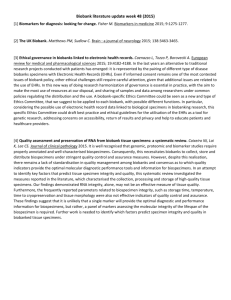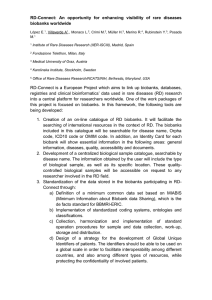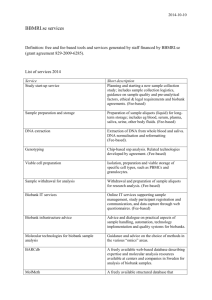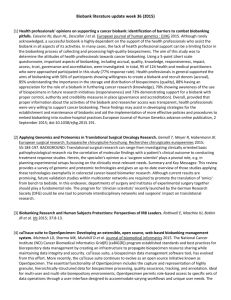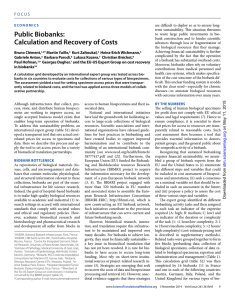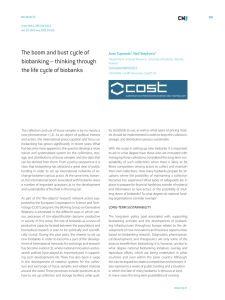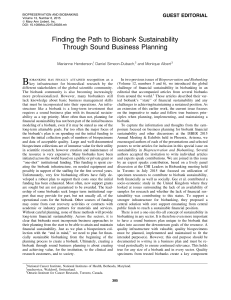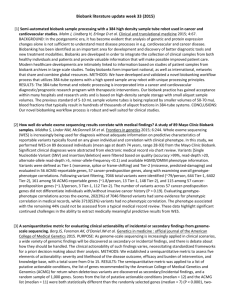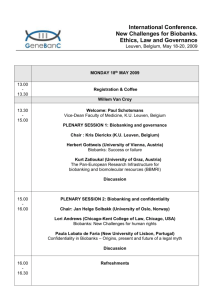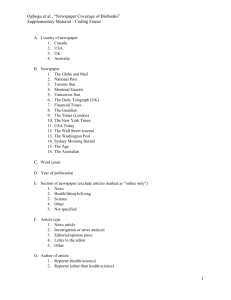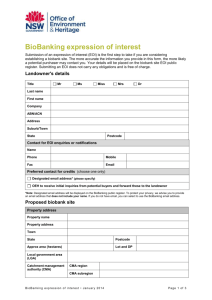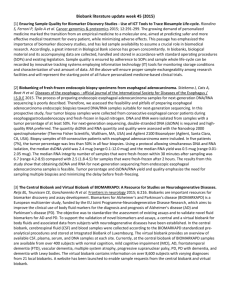Preserving Biopreservation
advertisement
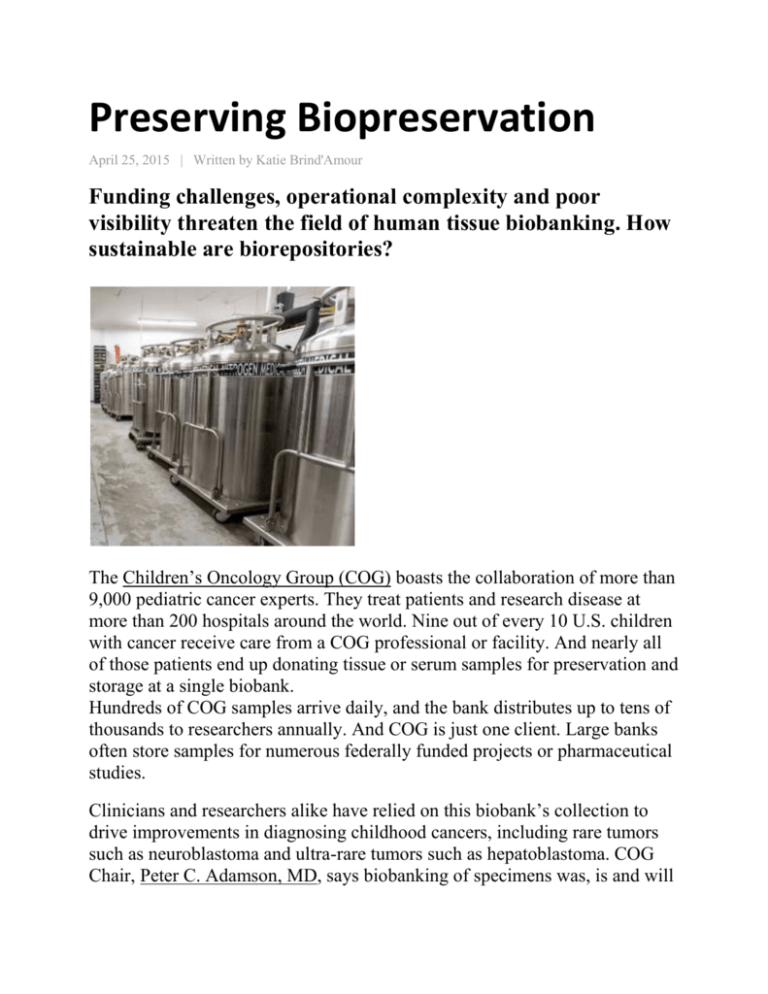
Preserving Biopreservation April 25, 2015 | Written by Katie Brind'Amour Funding challenges, operational complexity and poor visibility threaten the field of human tissue biobanking. How sustainable are biorepositories? The Children’s Oncology Group (COG) boasts the collaboration of more than 9,000 pediatric cancer experts. They treat patients and research disease at more than 200 hospitals around the world. Nine out of every 10 U.S. children with cancer receive care from a COG professional or facility. And nearly all of those patients end up donating tissue or serum samples for preservation and storage at a single biobank. Hundreds of COG samples arrive daily, and the bank distributes up to tens of thousands to researchers annually. And COG is just one client. Large banks often store samples for numerous federally funded projects or pharmaceutical studies. Clinicians and researchers alike have relied on this biobank’s collection to drive improvements in diagnosing childhood cancers, including rare tumors such as neuroblastoma and ultra-rare tumors such as hepatoblastoma. COG Chair, Peter C. Adamson, MD, says biobanking of specimens was, is and will continue to be crucial to the development and improvement of clinical therapies in pediatric oncology. But what if the biobank were to go out of business? The scenario is not hard to imagine. Facilities, such as the one at Nationwide Children’s Hospital hosting the COG samples, cost a fortune to start and an even greater fortune to maintain. Cuts in federal grant money, increasing equipment and personnel expenses and difficulty disseminating samples left over from large clinical trials add to the mounting challenges. The future of biobanking is uncertain and expensive. IT’S A BUSINESS. OR IS IT? Like any bank, biobanks accept deposits and safeguard them for many years, providing security and monitoring. They collect, process, store and distribute tissue, blood, serum and other human biospecimens for a wide range of clients — private individuals, large clinical trials, pharmaceutical companies, university research labs and others. Yet the standard bank analogy is too simple. At a regular bank, one dollar is the same as another. Clients don’t expect to withdraw the exact same dollar bills they deposited. Not so with biobanks, where a precise, annotated chain of custody is required for each sample. Thousands of slide drawers store hundreds of samples each at Nationwide Children’s Biopathology Center. It is the Biopathology Center (BPC) at Nationwide Children’s that houses the biobank for COG, which is funded by the National Cancer Institute. The BPC also houses other NCI-funded biospecimen collections, including those of SWOG(formerly the Southwest Oncology Group), the Gynecologic Oncology Group, The Cancer Genome Atlas and the Childhood Cancer Survivor Study. Nationwide Children’s internal investigators also base statewide and national grant-funded projects at the BPC, including the biospecimen collections for the Ohio Perinatal Research Network, The Cystic Fibrosis Therapeutics Development Network and the Nephrotic Syndrome Study Network. As the federal government continues to limit and even reduce funding for research projects, scientists — as well as biobanks and other industries their grant money supports — feel the effects. “Most of these grants are being cut consistently, at least 10 percent every year, so we’re doing way more than we end up being funded for,” explains Nilsa Ramirez, MD, director of the BPC and of surgical pathology at Nationwide Children’s. “If we lose one of these grants, it’s not like losing a single customer at a regular bank. Because of their large size, we’d lose a lot of business.” Having to juggle budgets and staff is not ideal, Dr. Ramirez concedes, but it’s necessary to the biobank’s survival. And thankfully, the hospital provides considerable support. “You have to have institutional support to survive, and in that sense we’re very lucky,” Dr. Ramirez says. “The biobanking efforts of the BPC are mainly supported by money from federal grants. However, this institution shares our vision and consistently provides us with great resources and an infrastructure that allows us to be incredibly successful.” Not all biobanks are fortunate enough to have a sponsor at the ready to cover facility costs, electricity or other expenses in a pinch. The reliance many hospital- and university-hosted biobanks have on their supporting institutions highlights the crux of the issue: biobanks struggle to be financially selfsufficient. “Most noncommercial biobanks do not have a good idea of their operating costs,” saysJim Vaught, PhD, editor-in-chief of Biopreservation and Biobanking and president-elect of the International Society for Biological and Environmental Repositories (ISBER). “They are often funded by central institutional budgets and have never thought of their biobank as a business operation.” Although commercial biobanks’ funding sources aren’t dependent to the same degree on the generosity of Congress, they face their own sustainability issues. “Industry biospecimen collections face many of the same challenges,” says Katheryn Shea, vice president of bioservices at Precision for Medicine — which runs a large commercial biorepository — and past president of ISBER. “The biobank grows and grows, and the cost to sustain the biobank increases over time.” A PROBLEM OF VOLUME Hundreds to thousands of samples arrive at the typical large biobank daily, but comparatively few leave. Many specimens are banked with the expectation that they’ll sit unused for upwards of a decade. It’s not a business designed for short-term profits. And most programs collect more than they need. These study leftovers, called “legacy” samples, are available for a service fee to approved researchers who make solid, relevant proposals to use samples for related research. “The samples that turn out to not be interesting from the scientific perspective of one researcher can often be greater than the number that end up being useful,” Shea says. “Finding ways to make archive collections known to the broader research community to maximize the use of the biospecimens by additional researchers is a challenge faced by many institutions.” Many federal grants now include funds for long-term storage of samples, but it is better to have them distributed and used rather than just sitting in storage. “We could get 10 important medical questions answered instead of one by getting more researchers access to those specimens,” Shea explains. Freezers cooled with liquid nitrogen enable storage of hundreds of slide racks. Short of creating a website that continually updates researchers on the archive collections available for research at each biobank, there’s no way to let people know what’s up for grabs. And while profitably offloading a greater number of otherwise unproductive specimens could help some banks, this solution — like other ideas for rescuing the endangered industry — is unlikely to be onesize-fits-all. According to Shea, the number of unused specimens banked could also be reduced by more conservative planning, balancing the number and type of specimens collected against the likelihood the assets will ever be needed. Well-designed trials could decrease the amount of tissue or blood that needs to be collected from participants while improving cost efficiency at the biobank. CHANGING THE MODUS OPERANDI Solving sustainability issues in biobanking is also, in part, about running a tight ship. Dr. Ramirez and her team construct business plans, mapping the life of major grants and expected funding over three to five years. “We usually know when a big dip in funding is coming and can try to make sure that whatever loss we envision we can complement with some other project being developed,” she says. “Things often end up evening out — we get another grant, technology improves or certain processes become cheaper. We always have to do a little bit of magic in there, but we still get everything taken care of properly.” Designing more space-efficient storage and automating certain procedures are additional ways to drive efficiency and decrease operating costs, Shea suggests. But redefining user expectations for the expenses associated with storing or obtaining biospecimens could be equally critical. “Users of specimens often have the perception that they should be free or very low cost, due to their limited knowledge about how much it costs to collect, process and store samples,” Dr. Vaught explains. At the same time, biobanks struggle to determine appropriate charges. “Quantifying expenses is difficult when direct and indirect expenses are covered by various funding resources,” Dr. Ramirez explains. “For grantfunded biobanking efforts like ours, it is a challenge to estimate 100 percent of our costs when there are so many variables to consider. We do our best to calculate them based on prior experiences and on the contributions of our expert BPC team, but it is a challenge.” This calculation is less difficult for commercial organizations but still requires regular evaluation and adjustments. Other potential solutions, such as reworking overarching business models, require more substantial adjustments. “Biobanking is not an inherently good business, since it’s difficult to recover a significant fraction of the operating costs,” Dr. Vaught says. “But in general, diversifying is good. Have a mixture of government grants or contracts, pharmaceutical or biotech partners and services for fees. And if staff has the expertise, biobanks could offer consulting services as well.” Dr. Vaught also believes that in order to achieve longterm sustainability, many noncommercial biobanking operations would have to develop comprehensive business plans and add ancillary services such as DNA extraction, private sample storage for a fee and more. Despite a bank’s best efforts, funding and volume of stored biospecimens fluctuates. And in such a volatile environment, any given biobank’s stability could be at risk. A FUTURE FOR BIOBANKING Despite the beleaguering day-to-day battles with bottom lines and shifting clientele, not all experts worry for the long-term survival of the field. “I believe that biospecimens are the future of medicine since they are a basic building block used in all scientific research, particularly as we navigate through the era of precision medicine and develop targeted approaches to improve health,” Shea says. Broader recognition of this fact, Dr. Ramirez explains, will eventually guarantee the perpetuation of biobanking as an industry. After all, she says, the future depends on it at least as much as the past has. Dr. Ramirez collaborates with other members of Nationwide Children’s Biopathology Center, the biobank for some of the world’s largest oncology research organizations. “There is probably not a childhood cancer where the biorepository hasn’t impacted our understanding of disease and, in certain cases, the treatment of disease,” says COG’s Dr. Adamson, who also is a pediatric oncologist at The Children’s Hospital of Philadelphia. “What will be central for future treatments is the study of well-annotated biospecimens — having biological material linked with knowledge of a child’s diagnosis, treatment and outcome. Without that, we will be extremely limited in our ability to bring 21st-century treatments to children with cancer in this country or in other parts of the world.” Studies involving the Nationwide Children’s BPC specimens have resulted in medical advances published in journals such as the New England Journal of Medicine, Cancer Cell, the Journal of Clinical Oncology and Blood. “Our ability to advance targeted new drugs and to improve outcomes is directly dependent on our ability to do leading edge research on specimens from our biorepositories,” Dr. Adamson says. “If we were to lose the biobanks, the impact would be devastating for childhood cancer.” The knowledge that these biobanks have truly made a difference in the clinical world helps motivate Dr. Ramirez and her colleagues when many biobanks face discouraging financial setbacks. “We want to make sure we are good stewards of these samples,” Dr. Ramirez says. “All those patients who were gutsy enough to donate specimens for banking 30 or 40 years ago contributed to the research that improved medical treatments, resulting in the incredible childhood cancer survival rates that you see now. If biobanks were not around, it would be catastrophic to the future of medical research and care.” Join the conversation. How could biobanks improve awareness of and access to legacy biospecimens for researchers? References 1. Angiolillo AL, Schore RJ, Devidas M, Borowitz MJ, Carroll AJ, et al.Pharmacokinetic and pharmacodynamic properties of calaspargase pegolEscherichia coli L-asparaginase in the treatment of patients with acute lymphoblastic leukemia: Results from Children’s Oncology Group Study AALL07P4. Journal of Clinical Oncology. 2014 Dec 1, 2(34):3874-82. 2. Perez-Andreu V, Roberts KG, Xu H, Smith C, Zhang H, et al. A genome-wide association study of susceptibility to acute lymphoblastic leukemia in adolescents and young adults. Blood. 2015 Jan 22, 125(4):680-6. 3. Roberts KG, Li Y, Payne-Turner D, Harvey RC, Yang YL, et al. Targetable kinase-activating lesions in Ph-like acute lymphoblastic leukemia. New England Journal of Medicine. 2014 Sep 11, 371(11):1005-15. 4. Walz AL, Ooms A, Gadd S, Gerhard DS, Smith MA, et al. Recurrent DGCR8, DROSHA, and SIX homeodomain mutations in favorable histology Wilms tumors. Cancer Cell. 2015 Feb 9, 27(2):286-97.
